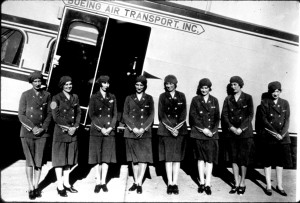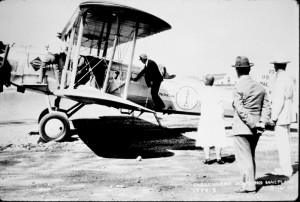By Karol Elwood, KCIA Operations and Facilities Coordinator

Flight attendants, all registered nurses, provided safety and passenger comfort on the early Boeing Air Transport flights.
Air carrier service at King County International Airport, also known as Boeing Field, has evolved through the years to keep pace with the ever-changing aviation industry and the needs of the flying public. For more than 75 years, millions of passengers have flown in and out of KCIA. Air carrier service started at Boeing Field in 1931, and continues to this day transporting passengers between northwest destinations. Passengers have traveled to many locations by means of various providers and aircraft.
Air carrier service at Boeing Field has an interesting history. Some say it was Charles Lindbergh’s first Atlantic solo flight that ignited the public’s interest in aviation. But in Seattle it started in 1928, when the citizens of King County made a commitment to support the early growth of The Boeing Company and the future development of the aviation industry by building an airport. Boeing Field was dedicated in July that same year as Seattle’s first municipal airport. Originally named Boeing Field in honor of The Boeing Company founder William Boeing, one of the Northwest’s great pioneers of aviation, the airport today is currently identified as King County International Airport at Boeing Field.
In the late 1920s and early 1930s, air service in and out of Boeing Field started primarily with mail service. Two Boeing companies, Pacific Air Transport and Boeing Air Transport, led the way for others delivering mail up and down the west coast, from Alaska to California and cities in between. An interesting fact is that these two companies later merged with National Air Transport to form the company known today as United Airlines.
Air carrier passenger travel began with air mail transport companies allowing curious travelers to ride with the mail in the back of the aircraft. According to historical information on United Airline’s website, “Adventurous travelers who dared to use the new mode of transport sat among mail sacks in cramped cabins, with neither heat in the winter nor air conditioning in the summer; these hearty souls endured the discomforts of air travel until bigger and more comfortable air transports came along.”
By the mid-1930s, an era for passenger transport had begun, and aircraft were being designed and built for the traveler’s comfort. This same year, Boeing Air Transport introduced the world’s first stewardess service with nurses serving coffee and sandwiches and tending to the comfort of apprehensive flyers. This was very successful and paved the way for flight attendants to secure an important role in commercial air passenger travel.
Passenger service grew with popularity and public usage continued to flourish until the beginning of World War II. During the war, the airport was closed to the public and taken over by the federal government, displacing air carrier service to Paine Field. Through the war years Boeing Field was devoted to the production of thousands of B-17 and B-29 bombers by The Boeing Company.
After the war, the airport reopened for civilian use and served as the primary passenger airport in the Seattle area until the development of Seattle-Tacoma International Airport in the late 1940s. Scheduled air passenger service to KCIA ended in 1971, leaving behind a thriving general aviation, cargo, corporate and chartered aircraft industry at Boeing Field. King County International Airport today is classified as a commercial non-hub airport and is considered one of the busiest of its kind in the world, with over 300,000 yearly operations.
It wasn’t until the 1990s that scheduled air carrier service started up again at King County International Airport/Boeing Field, with multiple small “commuter” carriers providing service between Seattle, the San Juan Islands and parts of British Columbia. This service provided passengers the opportunity to travel in smaller aircraft to nearby destinations. Helijet International Inc., Kenmore Air Express and San Juan Airlines faithfully provide daily flights from KCIA/Boeing Field. If you talk to passengers traveling through the terminal at KCIA/Boeing Field, they’ll tell you they enjoy the conveniences offered, including easy downtown access, less traffic congestion, free parking, and a smaller terminal with speedy check-in and boarding procedures.
Today, if you were to enter the newly remodeled terminal building at KCIA, you’d be captivated by the detail of the terrazzo floor designed by artists Ann Troutner and Paul Marioni. The artwork is titled “Our Place in Space,” and some say it symbolizes outer space and man’s future travels. Viewing the floor poses questions for our imagination … where will air travel take us in the future?
As we proceed through the 21st century, King County International Airport and its tenants will continue to meet the needs of the traveling public and provide services as air travel continues to evolve within the aviation industry.












